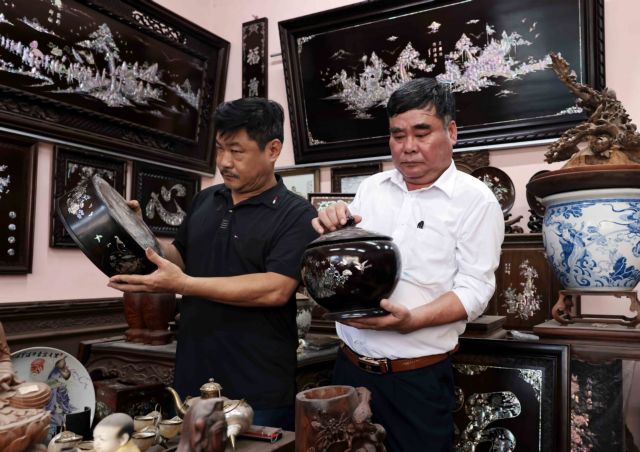 Life & Style
Life & Style

 |
| An artisan cutting mother-of-pearl and shell - the raw materials for mother-of-pearl inlay artwork. |
With a history spanning more than a millennium, the intricate art of mother-of-pearl inlay in Chuon Ngo Village, Chuyen My Commune, Phu Xuyen District (Hanoi) continues to thrive. Despite the passage of time, local artisans have meticulously preserved and elevated this traditional craft. Their exquisite creations have gone beyond national borders, reaching the continents and the world.
According to the village shrine's genealogy and local legends, mother-of-pearl inlay craftsmanship has existed in Chuyen My since as early as the 11th century. The people of Chuon Ngo revere General Truong Cong Thanh (1053-1099), who played a crucial role in Ly Thuong Kiet's conquest of Ung and Lam provinces, as the founder and patron saint of mother-of-pearl inlay.
 |
| An artisan sketching designs onto mother-of-pearl and shell. |
In the past, Chuon Ngo Village's mother-of-pearl inlay products were primarily used for ornate panels, couplets in temples and communal houses, and decorative motifs on rosewood beds and tea cabinets. Traditional themes such as “ The Three Kingdoms”, the "Four Gentlemen" (the plum blossom for winter, the orchid for spring, the bamboo for summer, and the chrysanthemum for autumn) or “ The Anecdote of Liu Bei's three visits to Zhuge Liang's thatched cottage" were popular choices.
 |
| Placing mother-of-pearl pieces on wood before cutting. |
However, to keep up with the evolving demands of modern society, Chuon Ngoi's mother-of-pearl inlay products have diversified significantly. Today, artisans create a wide range of decorative and souvenir items, including boxes, betel nut trays, teapots, couplets, landscapes, and portraits. They have also begun to incorporate embossed shells and mother-of-pearl carvings that combine high-tech techniques with traditional craftsmanship.
The creation of a mother-of-pearl inlay is a testament to the artisan's skill and creativity. The artisan undergoes a meticulous process, from sketching the design, cutting the mother-of-pearl pieces according to the pattern, adhering them to the wooden surface, and carving out the details, to gluing the mother-of-pearl pieces, sanding them flat, and using a steel knife to delicately separate and refine the small patterns. The final touches, including polishing and varnishing, bring the artwork to life with vibrant colors and depth.
 |
| An artisan refining and finishing the artwork. |
With decades of passionate dedication to preserving traditional craftsmanship, artisan Nguyen Dinh Hai was honored with the title of Artisan by the Vietnam Craft Villages Association in 2016 and recognized as a National Artisan in 2017. His significant contributions have propelled the development of Chuon Ngo Village's traditional inlay craft. As artisan Nguyen Dinh Hai shares that portrait inlay is considered the pinnacle of inlay techniques, demanding artisans not only possess exceptional carving skills but also a deep understanding of their subjects. This enables them to transform inanimate materials into lifelike portraits that capture the personality, spirit, and depth of thought of their subjects. Due to the complexity of this art form, the number of true 'artisan-craftsmen' in Chuon Ngo Village can now be counted on one hand.
Despite experiencing numerous ups and downs, the artisans of Chuon Ngo village have tirelessly preserved and promoted the essence of this traditional craft. Today, more than 70 per cent of households in the village are involved in mother-of-pearl inlay or related services, contributing to the craft's growth. Chuon Ngo's mother-of-pearl inlay products have transcended national borders, reaching demanding markets such as the UK, the Netherlands, the US, and Japan, thanks to their exquisite craftsmanship, harmonious color schemes, and lifelike depictions.
 |
| Display room of National Artisan Nguyen Dinh Hai’s family in Chuon Ngo Village. |
With calloused hands shaped by years of dedication and an unwavering passion for their craft, the artisans of Chuon Ngo have continuously innovated, ensuring that this traditional craft, deeply rooted in the thousand-year-old history of Thang Long, endures through time. VNS
This article was written with coordination from the Hà Nội Rural Development Department.




